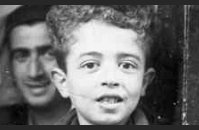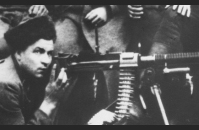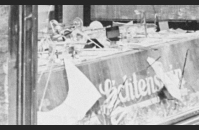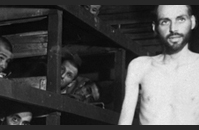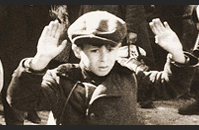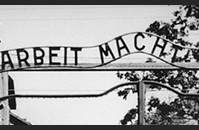THE HOLOCAUST AT A GLANCE:
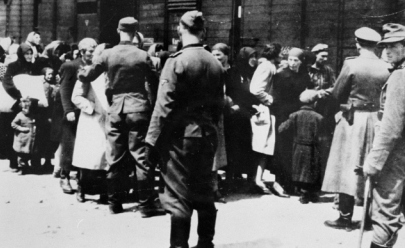
Image Gallery
The Holocaust: The War Against the Jews
The Holocaust was the Nazi regime’s deliberate, organized, and state-sponsored persecution and murder of approximately six million European Jews. Holocaust is a word of Greek origin that means “sacrifice by fire.”
Nazi ideology said that Germans were racially superior and that Jews were an inferior race and a threat to the survival of Germany. Anti-Semitism, or hatred of Jews, had a centuries-long history in Germany and throughout Europe, but reached its height during the Nazi era (1933-1945). The Nazis also claimed that Roma (Gypsies), Slavs (Poles, Russians), and physically and mentally disabled people were Untermenschen, or sub-human, and could therefore be treated inhumanely. Communists, socialists, Jehovah’s Witnesses, homosexuals and anyone who publicly disagreed with the Nazi regime were also persecuted, imprisoned and murdered.
The Nazis came to power in 1933 when their leader, Adolf Hitler, was made chancellor. Hitler rose to power in part by using Jews as scapegoats (made to bear the blame) for everything that had gone wrong in Germany—the loss of WWI, the Treaty of Versailles that punished Germany after the war, and the Great Depression. Jews were soon after forcibly removed from civil service jobs, medicine, the judicial system, and the military. Jewish businesses were boycotted or shut down. The Nuremburg Laws of 1935 denied Jews their German citizenship, forbade Jews to marry non-Jews, and took away most of their political rights.
During Kristallnacht, or the Night of Broken Glass (November 9, 1938), a violent riot against Jews organized by the Nazis, over 1,440 synagogues were burned, at least 91 people were murdered, countless Jewish businesses and homes were vandalized and destroyed, and 30,000 Jews were sent to Dachau, Buchenwald, Sachsenhausen and other concentration camps. By this point it had become very difficult for German Jews to leave Germany because few countries would take them in. At this point, too, it was difficult, if not impossible, for the world to claim it did not know how Jews were being treated in Nazi Germany.
Once WWII began (September 1, 1939) and the Nazis overran Europe, Jews in conquered countries were herded into ghettos—walled off sections of a city where the inhabitants lived in overcrowded, unsanitary conditions with a lack of food, medical services, and heat. Starvation and disease led to hundreds of thousands of deaths in the ghettos of Warsaw, Lodz, Vilnius, and many others. Many Jews went into hiding, often relying on the kindness and bravery of non-Jewish friends. To hide a Jew was dangerous and to be caught doing so meant prison or even death. Few Jews were able to survive the war by hiding, as most—like Anne Frank and her family—were found out and sent to concentration camps.
In January 1942, high-ranking Nazi party members met at in the town of Wannsee to discuss “the Final Solution of the Jewish question.” Hundreds of thousands of Jews were already in Nazi concentrations camps being used as slave labor for the German war effort. Beginning later that year, the Nazis started deportations from the ghettos and concentration camps to extermination camps—killing centers in Poland with specially designed gassing facilities, like Auschwitz, Treblinka, and Chelmno. With the efficiency of the entire German state behind the effort, trains loaded with Jewish men, women and children rolled daily into these killing centers. Most were sent directly to the gas chambers to be murdered.
There were notable efforts to resist the Holocaust. A number of armed uprisings in the ghettos and camps surprised the Nazis, but were ultimately put down. Some Jews escaped ghettos and joined partisan movements fighting against the Nazis. Within the ghettos and camps acts of defiance, small or large, were met with brutality and murder, but occurred all the same.
When the Soviets, Americans, and British began to close in on Germany in early 1945, the Nazis forced Jews on long marches away from the advancing Allied armies. Hundreds of thousands died of exposure, violence, and starvation on these death marches. As the Allies moved into Germany and Poland they liberated the concentration and extermination camps and were horrified by what they found. Although news reports about camps had earlier informed the world of these atrocities, it wasn’t until the camps were liberated that the full extent of the Nazi crimes against the Jewish people was exposed to the world.
“While not all victims were Jews, all Jews were victims. Jews were destined for annihilation solely because they were born Jewish. They were doomed not because of something they had done or proclaimed or acquired but because of who they were, sons and daughters of Jewish people. As such they were sentenced to death collectively and individually…”
—Elie Wiesel, writer, political activist, Nobel Peace Prize recipient, and Holocaust survivor
Download a printable version of this At A Glance
TAKE ACTION:


EDUCATION PROJECTS:
Student Travel – WWII Educational Tours
High school and college students, learn the leadership principles that helped win WWII on a trip to France or during a weeklong residential program in New Orleans. College credit is available, and space is limited.
See You Next Year! HS Yearbooks from WWII
Collected from across the United States, the words and pictures of these yearbooks present a new opportunity to experience the many challenges, setbacks and triumphs of the war through the eyes of America’s youth.
The Victory Gardens of WWII
Visit the Classroom Victory Garden Project website to learn about food production during WWII, find lesson plans and activities for elementary students, get tips for starting your own garden and try out simple Victory Garden recipes!
The Science and Technology of WWII
Visit our new interactive website to learn about wartime technical and scientific advances that forever changed our world. Incorporates STEM principles to use in the classroom.
Kids Corner: Fun and Games!
Make your own propaganda posters, test your memory, solve puzzles and more! Learn about World War II and have fun at the same time.


